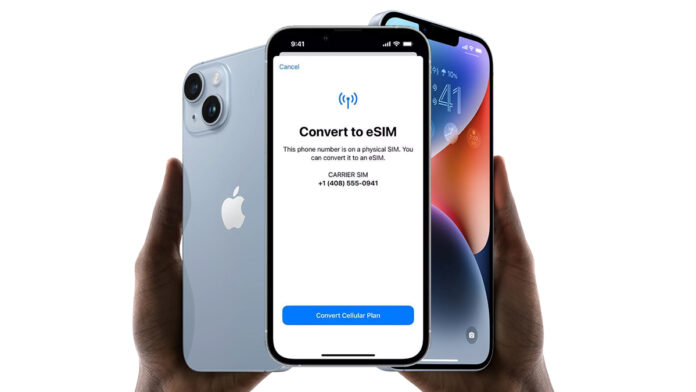Smartphones are regularly upgraded and in this modern world one of the latest innovations is the eSIM 🌐, which stands for electronic SIM card. It’s traditional SIM cards. eSIMs are pre-built phone future 📱, so there’s no need for a physical card or slot. This makes switching networks and managing mobile plans easier than ever. Apple is focusing more on eSIM technology and some people believe the new iPhone 15 Pro might not have a SIM card slot at all 🔮..
In case the rumors are true, this move will alter the iPhone lineup considerably, as until now the default was to have a physical SIM card slot in all of Apple’s iPhones. Yet, there are multiple factors that suggest Apple may get on board the train of the iPhone 15 Pro.
To begin with eSIM technology is considerably more advantageous than the traditional SIM cards. One of the supreme vital advantages is convenience✨. By an eSIM communication, customers can so easily start their service just by operating their 📲 device.
Customers can now easily switch operators from their smartphones eliminating the waiting time for a SIM card delivery to their postal address. This is absolutely best for frequent travelers who change networks often because they can simply swap between carriers at no extra cost or even add additional lines without the use of a physical SIM card. 🚫📦
One of the most important advantages of eSIM cards is easier access to local carriers and data plans when roaming internationally. Unlike traditional physical SIM cards, eSIMs eliminate the need for physically swapping cards and the hassle of finding local SIM card vendors. This convenience extends to cost savings, as eSIMs often provide more competitive and cost-effective options for international roaming.
They even provide various user-friendly options, as they can select different plans or carriers on-demand, this way, they get to customize connection 📶 to specific needs. ESIMs secure the most beneficial coverage by connecting to all the regional carriers, thereby, guaranteeing a reliable connection to even the remote areas..🏞️
The activation process is speedy, it takes only a few minutes, and another advantage of the application of eSIMs to the eco-friendliness 🌿 is the fact that it minimizes the use of physical SIM cards. They aggrandize the security 🔒 by means of being embedded in the gadget and authorizing the remote bloating or wiping if it is lost or stolen 🚨. By virtue of certain gadgets being able to handle several eSIM profiles, subscribers can have different data plans for dissimilar purposes.
The enhanced management of eSIMs by carriers from a distance, through tools such as plan changes and troubleshooting, makes them an eco-friendly technology for modern travelers.
eSIMs also are a space saver🧩 because they occupy smaller parts inside the device. Though they can be uncomfortable, physical SIM cards will become a thing of the past when manufacturers simplify the devices that users carry. By cutting off physical slots, a company would easily be on the right path in the future..🚀 No doubt, Apple iPhone 15 fits this description. Just slightly weight and thickness favorably lower than its predecessors, it may, thus, easily be adopted by users who place the utmost value on portability.
Moreover, eSIMs can provide greater safety 🔐 than physical SIM cards. Detachable SIM cards can be removed from your phone 📞 and added to someone else’s phone 🕵️♂️. This gives unauthorized users the ability to access your phone number, and to other personal information. When using an eSIM, your identity and information are bound directly to the device, which makes it virtually impossible for another person to use the number or access personal data. 🛡️
Also Read: best 5G Router With SIM Slot
On the other hand, eSIMs have their advantages from an environmental perspective 🌱. Plastic is the main component of physical SIM cards, which are also expensive to produce and distribute, thus bringing about negative effects on the environment 🌍. These days, by doing away with physical SIM cards, Apple could cut down its environmental footprint 🌿 and draw in eco-conscious users…
Even though using eSIMs provides these pros for Apple, the cons that should be addressed before making a decision to eliminate a physical SIM card slot from the iPhone 15 Pro remain. A common hurdle is compatibility. Although eSIM technology has been around for several years, still not all carriers provide. Sometimes, users might have to change carriers or plans in order to utilize the eSIM functionality.
Yet, eSIMs imitate another issue that is more difficult to set up than regular SIM cards. The process of eSIM activation is unique. Still, in most cases, it requires scanning a QR code and this might be a bit more hard than inserting a physical SIM card 🛠️ .
Lastly, there might be some worries about the cost of eSIMs. If eSIM cards are free of charge in some cases, the opposite is true in others where they impose fees or launch a specific plan that users must subscribe to 📋. Also, some users might have to get a new phone if their current one is not compatible with eSIMs, which can be a serious financial issue..💸
Also Read: Normal iPhone vs iPhone SE Difference
Nonetheless, the eSIMs are undoubtedly the future of mobile connectivity 🌐, and it is likely that as the years go by more and more devices will start adopting this technology...🚀
Here’s to the exciting future of eSIM technology and mobile innovation! 📲
Thanks for reading! 🙌✨


